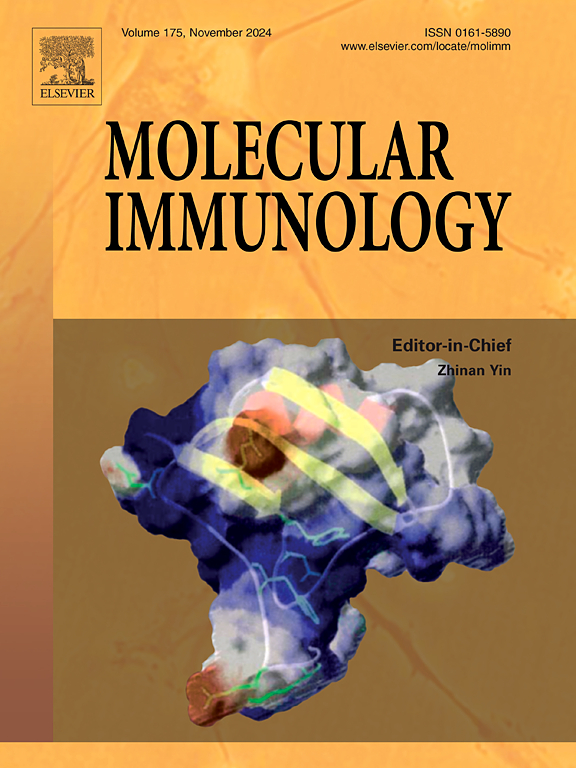远距离运输对西门特犊牛糖脂代谢和免疫功能的影响
IF 3
3区 医学
Q2 BIOCHEMISTRY & MOLECULAR BIOLOGY
引用次数: 0
摘要
本研究旨在探讨长途运输对西门塔尔小牛的影响。虽然已经确定长途运输可以影响动物健康,但对牛的葡萄糖和脂质代谢以及免疫功能的具体影响仍不充分了解。本研究分析了12头5月龄西门塔尔犊牛的血液样本,这些犊牛从内蒙古通辽市运输到山东省邹平市,运输距离1100 公里,运输时间为15 h。研究的重点是比较转运过程前后血清糖代谢、脂代谢和免疫参数的变化。研究结果表明,与运输前的水平相反,运输后糖酵解和戊糖磷酸途径相关的酶上调,导致葡萄糖利用增强。此外,发现肌酸激酶和乳酸脱氢酶水平升高。脂肪酸合成酶和乙酰辅酶a羧化酶活性也增加,总胆固醇和甘油三酯水平下降,同时非酯化脂肪酸升高。此外,高密度脂蛋白胆固醇水平上升,而低密度脂蛋白胆固醇水平下降。皮质醇水平呈上升趋势,白细胞介素-1β、白细胞介素-6、肿瘤坏死因子-α和免疫球蛋白g等促炎因子显著升高。由此可见,长途运输可能导致西门塔尔犊牛糖脂代谢紊乱、全身炎症和免疫功能障碍。本文章由计算机程序翻译,如有差异,请以英文原文为准。
Effects of long-distance transport on glycolipid metabolism and immune function in simmental calves
This study seeks to examine the effects of long-distance transportation on Simmental calves. While it is established that long-distance transportation can influence animal health, the specific impacts on glucose and lipid metabolism, as well as immune function in cattle, remain inadequately understood. This study analyzed blood samples from twelve 5-month-old Simmental calves that were transported over a distance of 1100 km from Tongliao City, Inner Mongolia, to Zouping City, Shandong Province, with a transportation duration of 15 h. The investigation focused on comparing alterations in serum glucose metabolism, lipid metabolism, and immune parameters before and after the transportation process. The findings indicated that, in contrast to pre-transportation levels, there was an upregulation of enzymes associated with glycolysis and the pentose phosphate pathway post-transportation, resulting in enhanced glucose utilization. Additionally, levels of creatine kinase and lactate dehydrogenase were found to be elevated. The activities of fatty acid synthase and acetyl-CoA carboxylase also increased, while total cholesterol and triglyceride levels decreased, accompanied by a rise in non-esterified fatty acids. Furthermore, high-density lipoprotein cholesterol levels increased, whereas low-density lipoprotein cholesterol levels decreased. Cortisol levels exhibited an upward trend, and there was a significant increase in pro-inflammatory cytokines, including interleukin-1β, interleukin-6, and tumor necrosis factor-α, as well as immunoglobulin G. In conclusion, long-distance transportation appears to induce disorders in glucose and lipid metabolism, systemic inflammation, and immune dysfunction in Simmental calves.
求助全文
通过发布文献求助,成功后即可免费获取论文全文。
去求助
来源期刊

Molecular immunology
医学-免疫学
CiteScore
6.90
自引率
2.80%
发文量
324
审稿时长
50 days
期刊介绍:
Molecular Immunology publishes original articles, reviews and commentaries on all areas of immunology, with a particular focus on description of cellular, biochemical or genetic mechanisms underlying immunological phenomena. Studies on all model organisms, from invertebrates to humans, are suitable. Examples include, but are not restricted to:
Infection, autoimmunity, transplantation, immunodeficiencies, inflammation and tumor immunology
Mechanisms of induction, regulation and termination of innate and adaptive immunity
Intercellular communication, cooperation and regulation
Intracellular mechanisms of immunity (endocytosis, protein trafficking, pathogen recognition, antigen presentation, etc)
Mechanisms of action of the cells and molecules of the immune system
Structural analysis
Development of the immune system
Comparative immunology and evolution of the immune system
"Omics" studies and bioinformatics
Vaccines, biotechnology and therapeutic manipulation of the immune system (therapeutic antibodies, cytokines, cellular therapies, etc)
Technical developments.
 求助内容:
求助内容: 应助结果提醒方式:
应助结果提醒方式:


